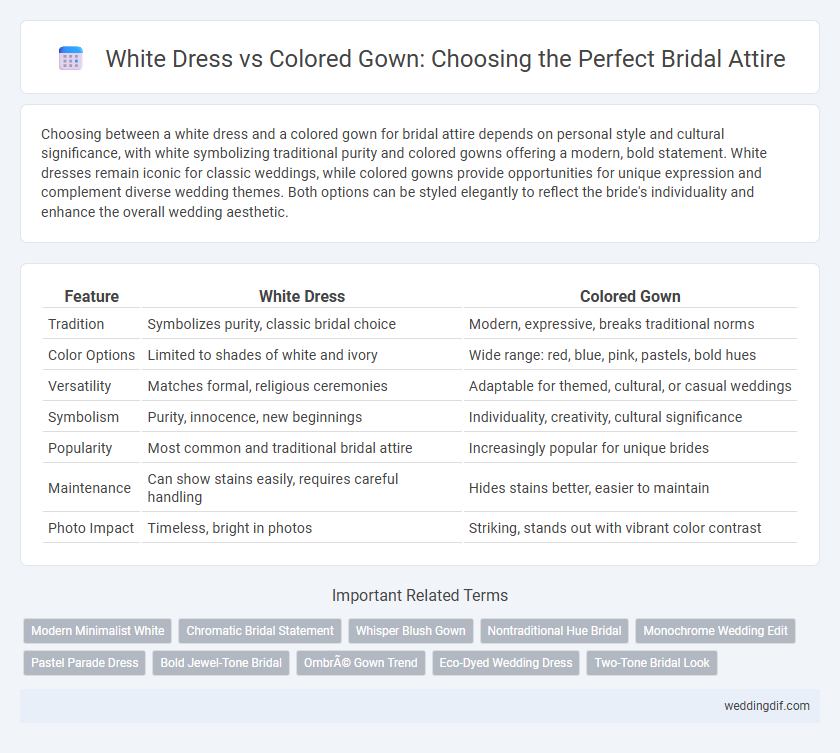Choosing between a white dress and a colored gown for bridal attire depends on personal style and cultural significance, with white symbolizing traditional purity and colored gowns offering a modern, bold statement. White dresses remain iconic for classic weddings, while colored gowns provide opportunities for unique expression and complement diverse wedding themes. Both options can be styled elegantly to reflect the bride's individuality and enhance the overall wedding aesthetic.
Table of Comparison
| Feature | White Dress | Colored Gown |
|---|---|---|
| Tradition | Symbolizes purity, classic bridal choice | Modern, expressive, breaks traditional norms |
| Color Options | Limited to shades of white and ivory | Wide range: red, blue, pink, pastels, bold hues |
| Versatility | Matches formal, religious ceremonies | Adaptable for themed, cultural, or casual weddings |
| Symbolism | Purity, innocence, new beginnings | Individuality, creativity, cultural significance |
| Popularity | Most common and traditional bridal attire | Increasingly popular for unique brides |
| Maintenance | Can show stains easily, requires careful handling | Hides stains better, easier to maintain |
| Photo Impact | Timeless, bright in photos | Striking, stands out with vibrant color contrast |
Introduction: The Tradition of Bridal Attire
The tradition of bridal attire has long been dominated by the classic white dress, symbolizing purity and new beginnings deeply rooted in Western culture since Queen Victoria's 1840 wedding popularized this trend. Modern brides increasingly opt for colored gowns, embracing personal expression and cultural diversity while challenging conventional norms. Choosing between a white dress and a colored gown reflects shifting attitudes toward individuality and the evolving meaning of wedding symbolism.
The Symbolism Behind the White Dress
The white dress in bridal attire symbolizes purity, innocence, and new beginnings, a tradition popularized by Queen Victoria in the 19th century. This color choice has become synonymous with weddings in Western cultures, representing a fresh start and the bride's commitment. While colored gowns offer personalization and cultural significance, the white dress remains a timeless emblem of matrimonial symbolism.
Rise of Colored Gowns in Modern Weddings
Colored gowns are gaining popularity in modern weddings as brides seek to express individuality beyond traditional white dresses. Shades such as blush, lavender, and deep blue offer personalized aesthetics while maintaining elegance, appealing to contemporary trendsetters. This shift reflects evolving bridal fashion trends driven by cultural diversity and a desire for unique wedding experiences.
Pros and Cons of White Dresses
White dresses symbolize traditional purity and elegance, making them a timeless choice for bridal attire with their ability to highlight intricate lace and beadwork. They offer versatility, matching well with various wedding themes and accessories, but may show stains more easily and can appear less unique in non-traditional settings. White dresses can sometimes feel restrictive for brides seeking to express individuality through bold colors or unconventional styles.
Benefits of Choosing a Colored Gown
Choosing a colored gown for bridal attire allows for personalized expression and stands out uniquely against traditional white dresses. Colored gowns offer versatility in coordinating with wedding themes, seasonal palettes, and cultural elements, enhancing the overall aesthetic experience. Brides opting for bold hues or subtle pastels often find that these choices create lasting visual impact and memorable wedding photography.
Cultural Perspectives on Bridal Colors
White wedding dresses symbolize purity and tradition in Western cultures, reflecting long-standing customs dating back to Queen Victoria's 19th-century wedding. In contrast, many Eastern cultures favor vibrant colored gowns, such as red in Chinese weddings symbolizing luck and prosperity, and gold or orange in Indian bridal attire representing wealth and spirituality. These cultural perspectives on bridal colors deeply influence bridal attire choices, emphasizing the importance of symbolism over mere aesthetics.
Popular Colored Gown Trends for Brides
Popular colored gown trends for bridal attire include soft pastels like blush pink, lavender, and powder blue, which add a romantic and modern twist to traditional wedding wear. Bold jewel tones such as emerald green, sapphire blue, and deep burgundy are favored for autumn and winter weddings, offering a rich and dramatic aesthetic. Metallic hues like gold and rose gold increasingly appeal to brides seeking glamorous and unconventional options that stand out from classic white dresses.
Factors to Consider When Choosing Dress Color
Choosing between a white dress and a colored gown for bridal attire involves considering personal style, cultural significance, and wedding theme. White dresses traditionally symbolize purity and elegance, while colored gowns offer a unique expression of personality and can complement seasonal or destination weddings. Factors such as skin tone, venue ambiance, and coordination with bridal party attire also play crucial roles in selecting the ideal dress color for a memorable wedding day.
Styling Tips for White vs Colored Bridal Gowns
White bridal gowns embody timeless elegance and pair beautifully with classic accessories like pearl or diamond jewelry, veils, and delicate lace details, enhancing their traditional charm. Colored bridal gowns offer a unique opportunity to experiment with bold accessories, contrasting shoes, and unconventional bouquet colors, allowing brides to express personal style and cultural heritage. When styling, consider skin tone and wedding theme to balance the dress color with complementary makeup, hairstyle, and jewelry choices for a harmonious bridal look.
Real Brides: Stories of White and Colored Wedding Dresses
Real brides share diverse experiences choosing between traditional white dresses and vibrant colored gowns for their wedding day, reflecting personal style and cultural significance. White dresses symbolize purity and timeless elegance, while colored gowns often represent individuality and modernity, with hues ranging from soft pastels to bold shades. These stories highlight how both options create memorable bridal looks, blending heritage with contemporary fashion trends.
White Dress vs Colored Gown for Bridal Attire Infographic

 weddingdif.com
weddingdif.com